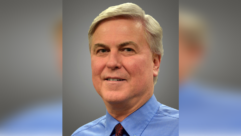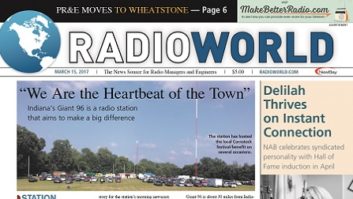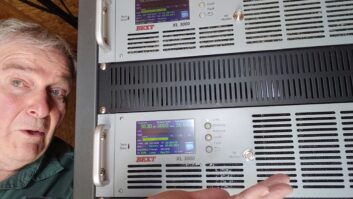One in a series of profiles of successful stations in all market sizes.
It was 1 a.m. on a Friday in January, but Tyson Conrady, program director of “Giant 96: Real Radio” in Shelbyville, Ind., was wide awake, out covering a news story for the station’s morning newscast.

The station has hosted the local Cornstock festival/benefit on several occasions.
It’s typical of how he sees his job. Like others on the staff, he handles a variety of duties: He is not only the afternoon drive announcer, but he also does production and engineering; and he reports on breaking news, whenever and wherever it occurs.
“People come to us for local news,” he said. “People trust us. They may also listen to the Indianapolis stations, but they know us, and they know we can give them [the information] they need.”
Giant 96 is about 30 miles from Indianapolis, market No. 38, and the station is within Nielsen’s Indianapolis metro. But the station does not pay much attention to what’s going on in the Indianapolis market. Like other successful small-market stations, Giant 96 has found a formula that works for it, seeking to be hyper-local and super-serving its community by covering local news and local sports; telling the audience about openings of new stores; providing important information for farmers; and broadcasting from local festivals and fairs in and around Shelby County. (“We can go live from just about anywhere,” Conrady says. “We use a refurbished Marti. It’s ‘Old Reliable.’”)
SMALL, DEDICATED TEAM

Then-Governor Mike Pence and wife Karen pose with Giant 96’s Tyson Conrady shortly before Pence was named as Donald Trump’s running mate.
The station began in 1961 as a directional AM daytimer with call letters WSVL and the slogan “The Giant of the Blue River Valley.” Today, WSVX(AM), owned by 3 Towers Broadcasting Co., is 260 watts non-directional by day with 4 watts at night, but also covers the entire county via an FM translator it acquired in 2008. So now Giant 96 is heard on both 1520 kHz and 96.5 MHz. Conrady believes the station was the first AM in Indiana to obtain an FM translator, a strategy that has since boomed in popularity around the country.
With only four full-time staff members and one part-timer, Giant 96 is able to serve its target audience in Shelby (population 18,000) and Shelby County (40,000). The station has no syndicated programming. While it does use some voice-tracking, it is live and local during most of the broadcast day, and it will readily break away from voice-tracking for an important story. In winter, that means keeping listeners updated about potential weather emergencies like ice storms.
Giant 96 has owners who live in the community and work at the station: Scott Huber is general manager, and Johnny McCrory is the news and sports director.
Huber, 47, was raised in Shelbyville; he worked for the local newspaper and he ran a printing and office supply store before coming to Giant 96 in 2001. McCrory, 45, came to the area after working in college radio in Carbondale, Ill., and at several small-market stations; he joined what was then WOOO in 1998. Two other members of their original business group, Douglas Raab and Todd Glidden, have since died.
Owning a small-market radio station has had its challenges at times, but Giant 96 has surprised a lot of people. Huber remembers their early conversations about buying the AM, which by 2005 was failing, its owners ready to give up on it.

Penny Lane talks with Paul Gable from Helping Hands for Freedom.
“People thought I was crazy to want to buy it. [The station] was losing money hand over fist. But I didn’t want to see it go dark. Back then, nobody thought we’d last two years, let alone 10. But we’ve more than doubled our revenue from when we bought the station. The economy has had its ups and downs, but our revenue has been very steady.”
Huber declined to state the station’s revenue but said Giant 96 has been consistently profitable, and he praised area businesses — especially the local hospital, several car dealerships and several banks — that have been consistent advertisers.
Typically, Giant 96 runs between 10 and 12 half-minute spots per hour. Huber says, “There are lots of packages for events like high school sports.” The station has found another revenue stream with its website, where online ads now generate between 8 and 10 percent of its sales.
Huber sees being in a smaller market as a benefit.
“Small markets perform very well in tough economic times. [Stores] want to bring in customers, and they’re looking for people to help them grow their business. [Radio] can help them with that. Because we’re in a small market, we can stay ahead of the curve, and react to new trends.” Having the translator, he said, helped the station through the hardest part of the recession and also to keep up with an audience moving to FM.

Johnny McCrory interviews a nurse at a local hospital.
The station is unrated, by choice. “It’s not worth it for us,” Huber said. But he can sense that the community pays attention to what Giant 96 is doing. “We measure by interactions on social media. We get 70,000 views a month on our web page, and we have about 80,000 followers on Facebook and YouTube … We’re not just on the air; we can use our website and social media to enhance our on-air product.” The station also has a mobile app that allows listeners to hear it anytime from anywhere.
Co-owner Johnny McCrory hosts the morning show and covers local sports, including play-by-play of such key events as the Shelby County basketball tournament and covering Shelbyville High School football. McCrory is also actively involved in the station’s day-to-day operation. He’s up early to prepare for the morning show, and on many nights, he’s working late broadcasting the games. He rewrites the latest news stories so they can be posted to the station’s website, and like several others on the staff he sometimes blogs.
While such work keeps him constantly busy, McCrory says he loves every minute of it. He’s proud of the station’s reputation. “I want people to hear a station that comes from a small community but doesn’t sound like a small [market] station,” he says.
On a recent February day, top stories on the station website included a fire at Fairland First United Methodist Church; the death a local restaurant owner; and the hiring of a vice president/agricultural manager at a local bank. The site also featured a section called “Giant 96 TV,” which had a number of video interviews with local newsmakers, done by station staff.
MUSIC MIX

The Giant 96 Real Radio “Action Trailer” is a full broadcast studio.
The AM airchain includes a Harris Gates One transmitter, Orban processing, EV microphones, Dynamax console and iMediaTouch automation; critical FM components include a Crown FM300 transmitter, Omnia processor and Jampro antenna. The station’s 343-foot tower, located in its backyard, serves both the AM and FM signals.
Giant 96 has a top-40 format and uses MusicMaster to schedule songs. It airs its own unique version of top 40.
“We don’t live and die by the [pop] charts,” said Conrady. “We try to play the songs that are right for our audience. We know we are competing with Spotify and Pandora, so it’s important for us to play the very best songs. We play some local music, and some national hits. We’ll even play country if it fits.”
The variety of music on the station means mid-day announcer Penny Lane Diersing can play some blues. In fact, she takes her show to Memphis for live coverage of the annual International Blues Challenge. She is also known for her interviews with local and regional musicians, some of whom have played live, acoustic sets on her show.
Whether she is interviewing a musician or talking to a community leader, “I’m always trying to create a connection with the audience,” she said. “It’s like [they are] sitting on the couch listening to the stories the guests are telling, or listening to musicians playing live.” In addition to her air shift, she does some sales, a job with which she is familiar. Prior to working at Giant 96, she sold cars; and she and her husband ran a business that trained people in how to sell.

Mitch Columbe signs up a listener for a drawing at the Shelby County Fair.
Working for a small station often means long hours, and everyone at the station acknowledges they could make more money in a larger market; yet the staff express loyalty to Giant 96. Penny Lane said, “I would never want to work for a corporate station. I have more freedom here.”
Huber understands that feeling. “We can’t offer huge salaries, but we’re very family-oriented. We’re there for them when they need us.”
And people do stay for long periods of time. “General Sales Manager John Schoentrup has been here off and on for 20 years; and his mom used to work here … People want to feel like they’re a part of something, that they have a say in how the company goes forward.”
The sense of involvement in the station’s future is important to the staff; so is being able to interact with the audience. Tyson Conrady, who would like to work in politics someday, loves Shelby County. “I can walk into a local store and people know me, and I know them.”
Terrestrial radio is changing, he acknowledges. “But I think there will continue to be a place for local radio — we are the heartbeat of the town.”
Donna Halper profiled WATD(FM) in Marshfield, Mass., in the Jan. 4 issue; read it at radioworld.com/watd.
Got a suggestion for this series? Tell us why you think a station or group is noteworthy as an example of radio success. Email [email protected] with “Station Profile” in the subject line.











